1 stack容器
1.1 概念

1.2 常用接口
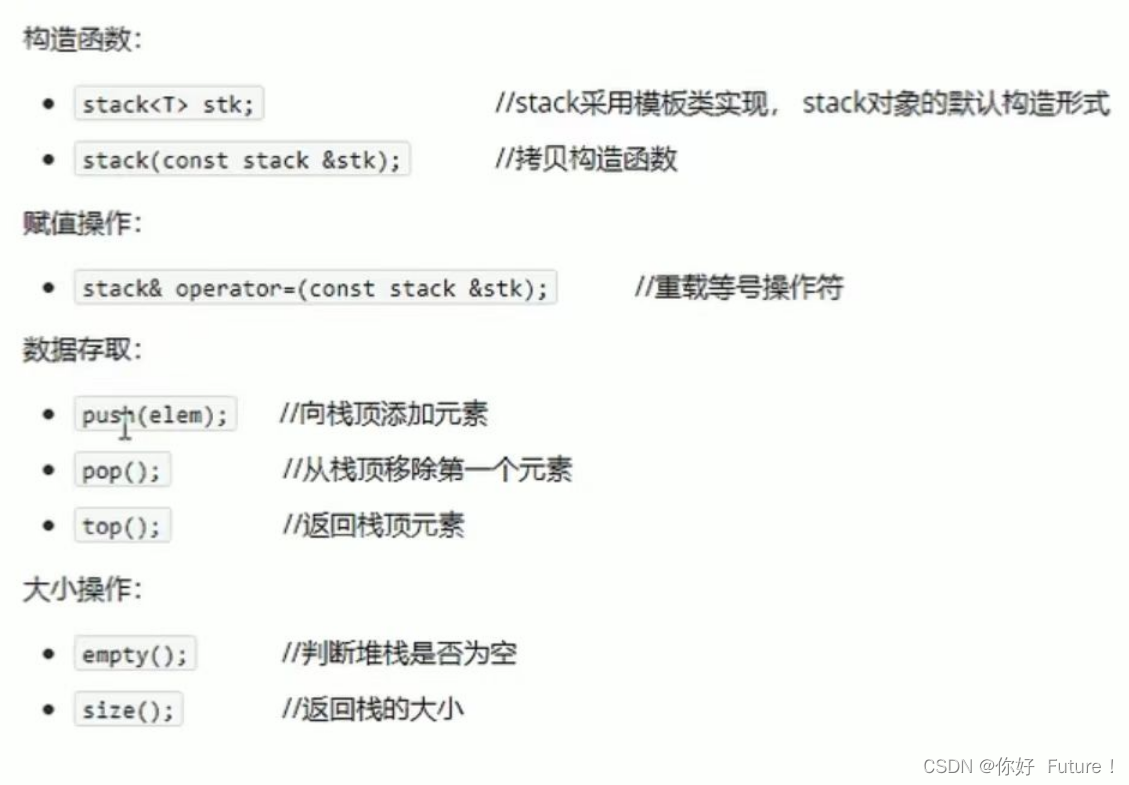
#include<stack>
#include<iostream>
using namespace std;
int main() {
//1.构造
stack<int> s; //默认构造
stack<int> s1(s); //拷贝构造
//2.元素进栈
for (int i = 10; i < 60; i += 10) {
s.push(i);
}
//3.计算栈的大小
cout << "栈的大小为:" << s.size() << endl;
//4.返回栈顶元素以及出栈
while (!s.empty()) {
cout << "栈顶元素为:" << s.top() << endl;
s.pop();
}
return 0;
}栈的大小为:5
栈顶元素为:50
栈顶元素为:40
栈顶元素为:30
栈顶元素为:20
栈顶元素为:102 queue容器
2.1 概念
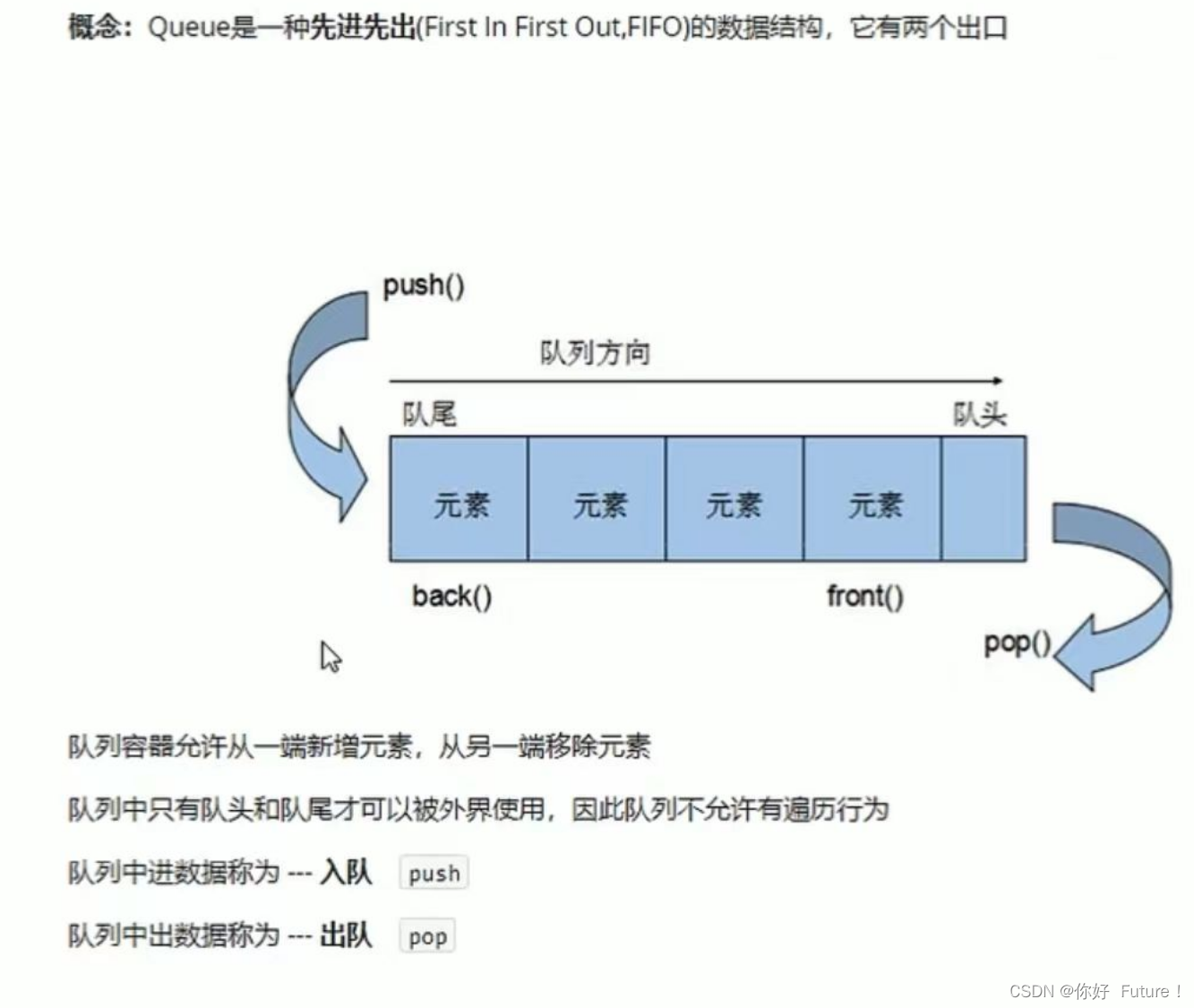
2.2 常用接口
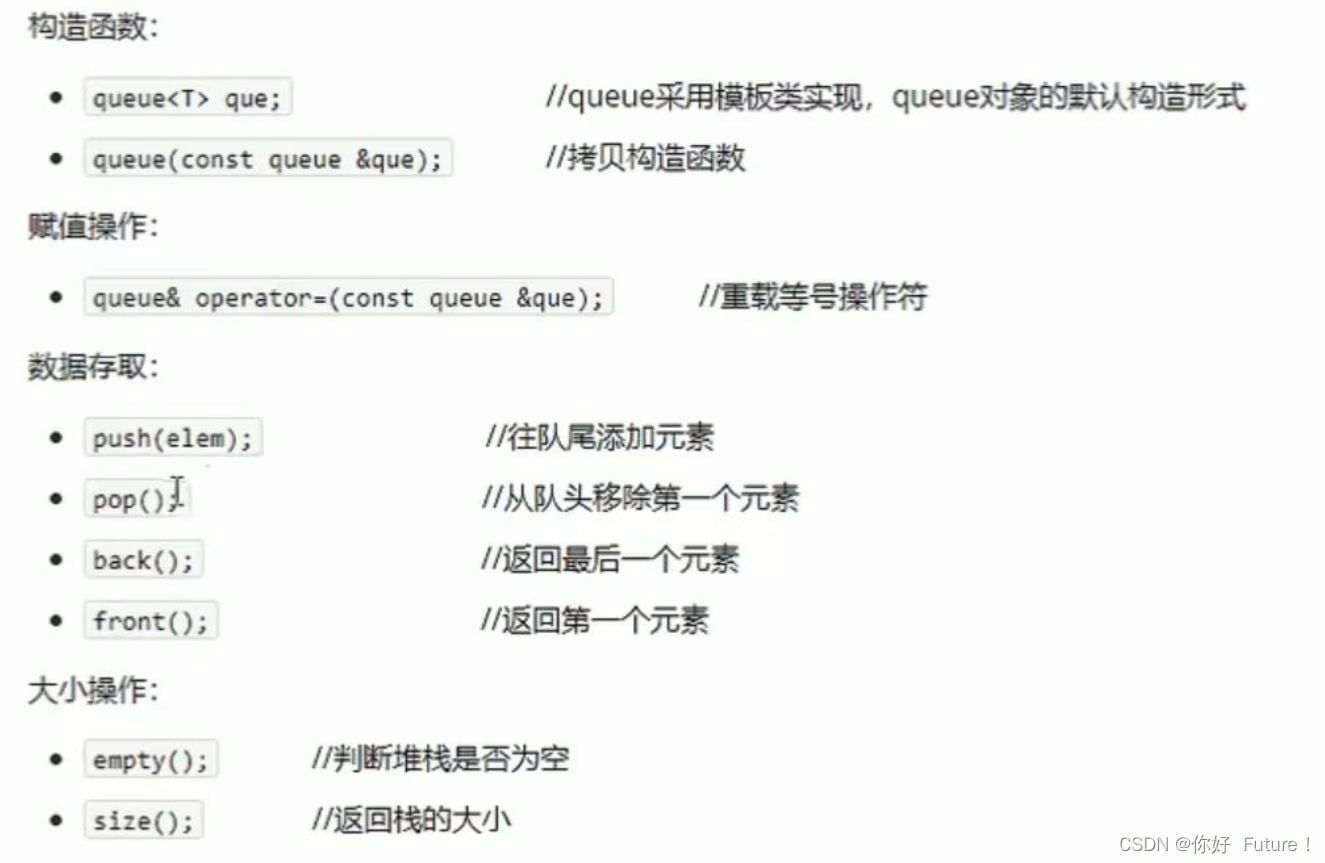
#include<queue>
#include<iostream>
using namespace std;
int main() {
//1.构造
queue<int> q; //默认构造
queue<int> q1(q); //拷贝构造
//2.元素从队尾入队
for (int i = 10; i < 60; i += 10) {
q.push(i);
}
//3.计算队列的大小
cout << "队列的大小为:" << q.size() << endl;
//4.返回队头、队尾元素以及出队
cout << "队尾元素为:" << q.back() << endl;
while (!q.empty()) {
cout << "队头元素为:" << q.front() << endl;
q.pop();
}
return 0;
}队列的大小为:5
队尾元素为:50
队头元素为:10
队头元素为:20
队头元素为:30
队头元素为:40
队头元素为:503 list容器
3.1 基本概念

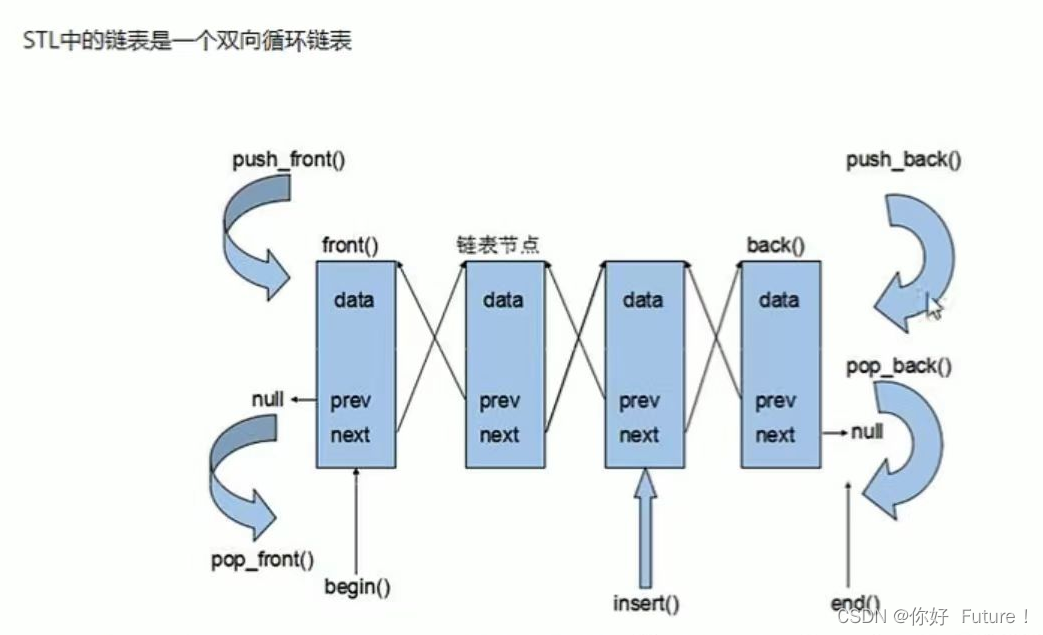

3.2 常用接口
3.2.1 构造函数

#include<iostream>
#include<list>
using namespace std;
void printList(const list<int>&L) {
for (list<int>::const_iterator it = L.begin(); it != L.end(); it++) {
cout << *it << " ";
}
cout << endl;
}
int main() {
list<int>L1;
L1.push_back(10);
L1.push_back(20);
L1.push_back(30);
L1.push_back(40);
cout << "方式一" << endl;
printList(L1);
list<int>L2(L1.begin(), L1.end());
cout << "方式二" << endl;
printList(L2);
list<int>L3(3, 10);
cout << "方式三" << endl;
printList(L3);
list<int>L4(L3);
cout << "方式四" << endl;
printList(L4);
return 0;
}方式一
10 20 30 40
方式二
10 20 30 40
方式三
10 10 10
方式四
10 10 103.2.2 赋值和交换

#include<iostream>
#include<list>
using namespace std;
void printList(const list<int>&L) {
for (list<int>::const_iterator it = L.begin(); it != L.end(); it++) {
cout << *it << " ";
}
cout << endl;
}
int main() {
list<int>L1;
L1.push_back(10);
L1.push_back(20);
L1.push_back(30);
L1.push_back(40);
list<int>L2;
L2.assign(L1.begin(), L1.end());
cout << "方式一" << endl;
printList(L2);
list<int>L3;
L3.assign(3, 10);
cout << "方式二" << endl;
printList(L3);
list<int>L4;
L4 = L3;
cout << "方式三" << endl;
printList(L4);
cout << "交换前" << endl;
printList(L2);
printList(L3);
L2.swap(L3);
cout << "交换后" << endl;
printList(L2);
printList(L3);
return 0;
}方式一
10 20 30 40
方式二
10 10 10
方式三
10 10 10
交换前
10 20 30 40
10 10 10
交换后
10 10 10
10 20 30 403.2.3 大小操作
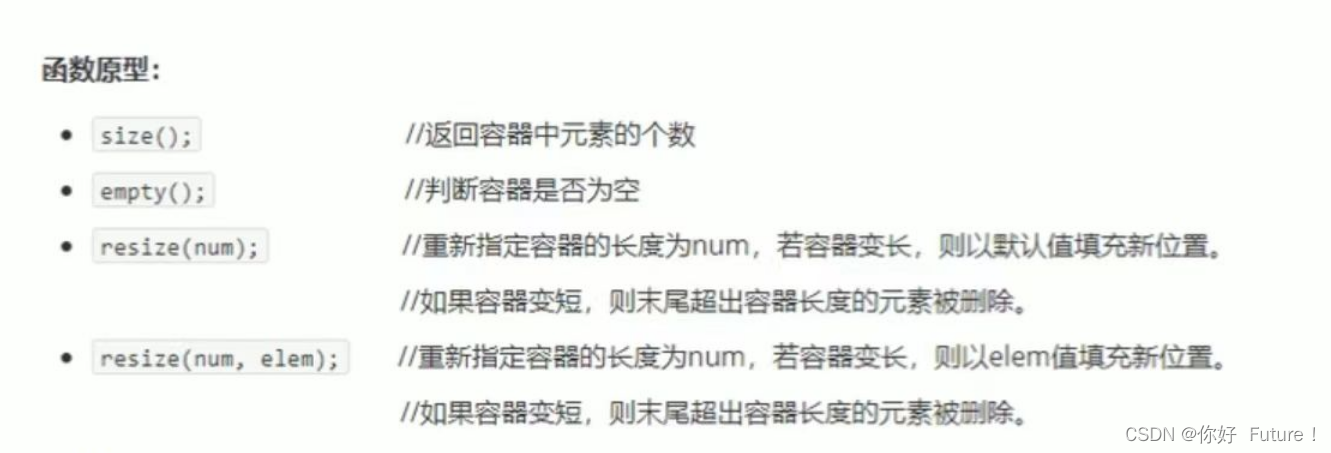
#include<iostream>
#include<list>
using namespace std;
void printList(const list<int>&L) {
for (list<int>::const_iterator it = L.begin(); it != L.end(); it++) {
cout << *it << " ";
}
cout << endl;
}
int main() {
list<int>L1;
L1.push_back(10);
L1.push_back(20);
L1.push_back(30);
L1.push_back(40);
if (L1.empty()) {
cout << "容器为空" << endl;
}
else {
cout << "容器中的元素个数为:" << L1.size() << endl;
}
L1.resize(6);
printList(L1);
L1.resize(4);
printList(L1);
cout << "------" << endl;
L1.resize(6,3);
printList(L1);
L1.resize(4);
printList(L1);
return 0;
}容器中的元素个数为:4
10 20 30 40 0 0
10 20 30 40
------
10 20 30 40 3 3
10 20 30 403.2.4 插入和删除
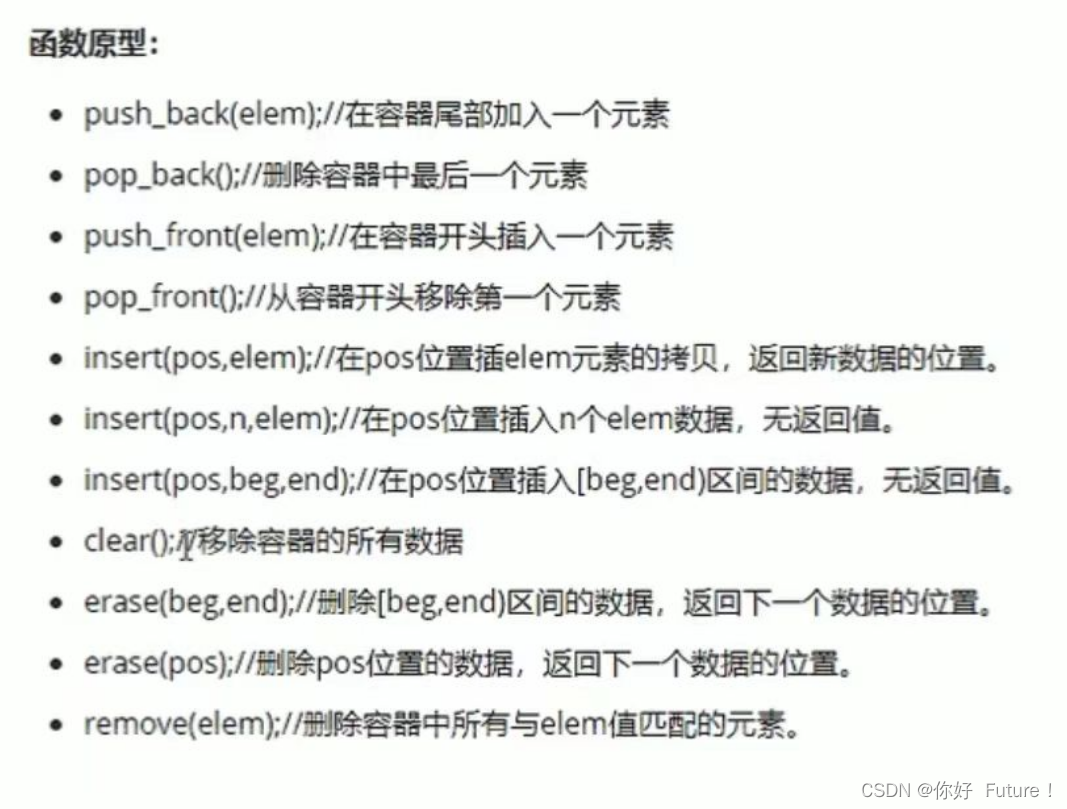
#include<iostream>
#include<list>
using namespace std;
void printList(const list<int>& L) {
for (list<int>::const_iterator it = L.begin(); it != L.end(); it++) {
cout << *it << " ";
}
cout << endl;
}
int main() {
list<int>L1;
//1 插入
//10 20
L1.push_back(10);
L1.push_back(20);
cout << "一:";
printList(L1);
//40 30 10 20
L1.push_front(30);
L1.push_front(40);
cout << "二:";
printList(L1);
//2 删除
//40 30 10
L1.pop_back();
cout << "三:";
printList(L1);
//30 10
L1.pop_front();
cout << "四:";
printList(L1);
//3 insert插入
//30 20 10
list<int>::iterator it = L1.begin();
cout << "插入的新数据为:" << *L1.insert(++it, 20) << endl;
cout << "五:";
printList(L1);
//30 1 1 20 10
it = L1.begin();
L1.insert(++it, 2, 1);
cout << "六:";
printList(L1);
//30 9 9 1 1 20 10
it = L1.begin();
list<int>L2(2, 9);
L1.insert(++it, L2.begin(), L2.end());
cout << "七:";
printList(L1);
//4 erase删除
//30 9 1 1 20 10
it = L1.begin();
it++;
list<int>::iterator bt = it;
bt++;
cout << "删除后下一个元素为:" << *L1.erase(it, bt) << endl;
cout << "八:";
printList(L1);
//9 1 1 20 10
it = L1.begin();
cout << "下一个元素为:" << *L1.erase(it) << endl;
cout << "九:";
printList(L1);
//5 remove删除
//9 20 10
L1.remove(1);
cout << "十:";
printList(L1);
//6 清空
L1.clear();
cout << L1.size() << endl;
return 0;
}一:10 20
二:40 30 10 20
三:40 30 10
四:30 10
插入的新数据为:20
五:30 20 10
六:30 1 1 20 10
七:30 9 9 1 1 20 10
删除后下一个元素为:9
八:30 9 1 1 20 10
下一个元素的位置为:9
九:9 1 1 20 10
十:9 20 10
03.2.5 数据存取
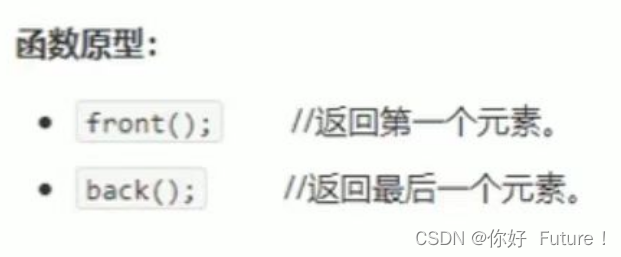
#include<iostream>
#include<list>
using namespace std;
void printList(const list<int>&L) {
for (list<int>::const_iterator it = L.begin(); it != L.end(); it++) {
cout << *it << " ";
}
cout << endl;
}
int main() {
list<int>L1;
L1.push_back(10);
L1.push_back(20);
L1.push_back(30);
L1.push_back(40);
cout << L1.front() << endl;
cout << L1.back() << endl;
return 0;
}10
403.2.6 反转和排序

#include<iostream>
#include<list>
using namespace std;
void printList(const list<int>&L) {
for (list<int>::const_iterator it = L.begin(); it != L.end(); it++) {
cout << *it << " ";
}
cout << endl;
}
int main() {
list<int>L1;
L1.push_back(20);
L1.push_back(10);
L1.push_back(30);
L1.push_back(40);
L1.reverse();
printList(L1);
L1.sort();
printList(L1);
return 0;
}40 30 10 20
10 20 30 403.2.7 排序案例

#include<iostream>
#include<list>
using namespace std;
class Person {
public:
Person(string name, int age, int height) {
m_name = name;
m_age = age;
m_height = height;
}
public:
string m_name;
int m_age;
int m_height;
};
void printList(const list<Person>&L) {
for (list<Person>::const_iterator it = L.begin(); it != L.end(); it++) {
cout << "姓名:"<< (*it).m_name<<" " << "年龄:" << (*it).m_age << " " << "身高:" << (*it).m_height << " "<<endl;
}
}
bool comparePerson(Person& p1, Person& p2) {
if (p1.m_age == p2.m_age) {
return p1.m_height > p2.m_height;
}
return p1.m_age < p2.m_age;
}
int main() {
list<Person>L1;
Person p1("刘备", 20, 168);
Person p2("关羽", 18, 179);
Person p3("张飞", 50, 155);
Person p4("李白", 50, 101);
L1.push_back(p1);
L1.push_back(p2);
L1.push_back(p3);
L1.push_back(p4);
cout << "排序前:" << endl;
printList(L1);
cout << "排序后:" << endl;
L1.sort(comparePerson);
printList(L1);
return 0;
}排序前:
姓名:刘备 年龄:20 身高:168
姓名:关羽 年龄:18 身高:179
姓名:张飞 年龄:50 身高:155
姓名:李白 年龄:50 身高:101
排序后:
姓名:关羽 年龄:18 身高:179
姓名:刘备 年龄:20 身高:168
姓名:张飞 年龄:50 身高:155
姓名:李白 年龄:50 身高:1014 set(multiset)容器
4.1 基本概念
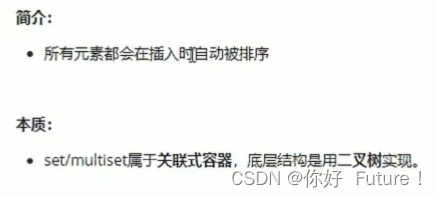
4.2 常用接口
4.2.1 构造和赋值
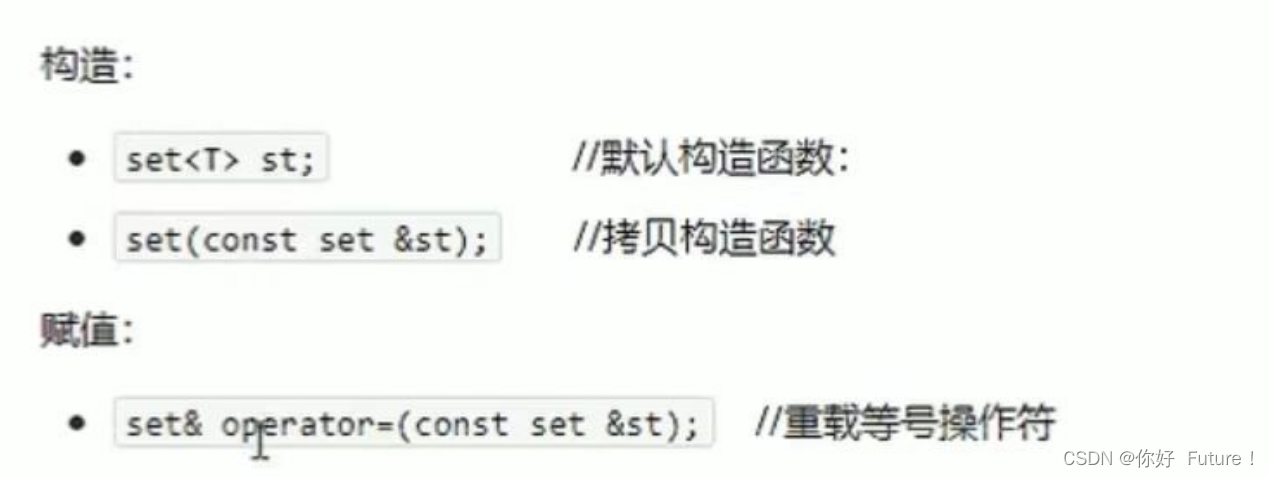
#include<iostream>
#include<set>
using namespace std;
void printSet(const set<int>& L) {
for (set<int>::const_iterator it = L.begin(); it != L.end(); it++) {
cout << *it << " ";
}
cout << endl;
}
int main() {
//默认构造
set<int> s1;
s1.insert(50);
s1.insert(40);
s1.insert(530);
printSet(s1);
//拷贝构造
set<int>s2(s1);
printSet(s2);
//等号
set<int>s3;
s3 = s2;
printSet(s3);
return 0;
}40 50 530
40 50 530
40 50 5304.2.2 大小和交换
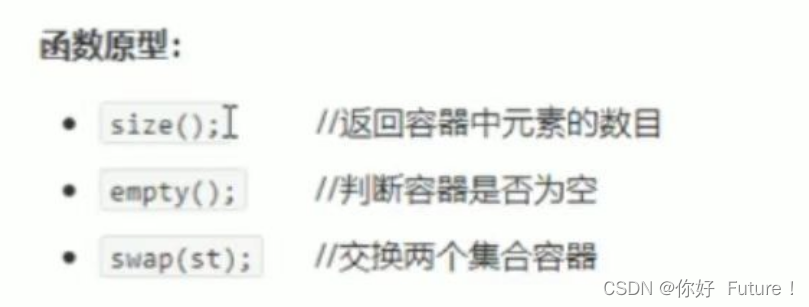
#include<iostream>
#include<set>
using namespace std;
void printSet(const set<int>& L) {
for (set<int>::const_iterator it = L.begin(); it != L.end(); it++) {
cout << *it << " ";
}
cout << endl;
}
int main() {
set<int> s1;
s1.insert(50);
s1.insert(40);
s1.insert(530);
if (s1.empty()) {
cout << "容器为空" << endl;
}
else {
cout << "容器中的元素个数为:" << s1.size() << endl;
}
set<int> s2;
s2.insert(10);
s2.insert(30);
s2.insert(20);
//交换操作
cout << "交换前" << endl;
printSet(s1);
printSet(s2);
s2.swap(s1);
cout << "交换后" << endl;
printSet(s1);
printSet(s2);
return 0;
}容器中的元素个数为:3
交换前
40 50 530
10 20 30
交换后
10 20 30
40 50 5304.2.3 插入和删除
#include<iostream>
#include<set>
using namespace std;
void printSet(const set<int>& L) {
for (set<int>::const_iterator it = L.begin(); it != L.end(); it++) {
cout << *it << " ";
}
cout << endl;
}
int main() {
set<int> s1;
s1.insert(50);
s1.insert(40);
s1.insert(530);
s1.insert(30);
//30 40 50 530
printSet(s1);
//40 50 530
s1.erase(s1.begin());
printSet(s1);
//50 530
s1.erase(40);
printSet(s1);
s1.erase(s1.begin(), s1.end());//等价于s1.clear();
if (s1.empty()) {
cout << "容器为空" << endl;
}
return 0;
}30 40 50 530
40 50 530
50 530
容器为空
4.2.4 查找和统计

#include<iostream>
#include<set>
using namespace std;
int main() {
set<int> s1;
s1.insert(50);
s1.insert(40);
s1.insert(530);
s1.insert(30);
//30 40 50 530
set<int>::iterator pos = s1.find(40);
if (pos == s1.end()) {
cout << "该元素未找到" << endl;
}
else {
cout << "该元素是:"<< *pos << endl;
}
cout << "set中有" << s1.count(40) << "个40" << endl;
return 0;
}该元素是:40
set中有1个404.2.5 改变排序规则
#include<iostream>
#include<set>
using namespace std;
class MyCompare {
public:
bool operator()(int v1, int v2) const{
return v1 > v2;
}
};
void printSet(const set<int, MyCompare>& S) {
for (set<int, MyCompare>::const_iterator it = S.begin(); it != S.end(); it++) {
cout << *it << " ";
}
cout << endl;
}
int main() {
set<int,MyCompare> s1;
s1.insert(50);
s1.insert(40);
s1.insert(530);
s1.insert(30);
printSet(s1);
return 0;
}530 50 40 304.2.6 自定义数据类型指定排序规则
#include<iostream>
#include<set>
using namespace std;
class Person {
public:
Person(string name, int age, int height) {
m_name = name;
m_age = age;
m_height = height;
}
public:
string m_name;
int m_age;
int m_height;
};
class ComparePerson {
public:
bool operator()(const Person& p1,const Person& p2) const{
if (p1.m_age == p2.m_age) {
return p1.m_height > p2.m_height;
}
return p1.m_age <= p2.m_age;
}
};
void printList(const set<Person, ComparePerson>& S) {
for (set<Person, ComparePerson>::const_iterator it = S.begin(); it != S.end(); it++) {
cout << "姓名:" << (*it).m_name << " " << "年龄:" << (*it).m_age << " " << "身高:" << (*it).m_height << " " << endl;
}
}
int main() {
set<Person,ComparePerson>s1;
Person p1("刘备", 20, 168);
Person p2("关羽", 18, 179);
Person p3("张飞", 50, 155);
Person p4("李白", 50, 101);
s1.insert(p1);
s1.insert(p2);
s1.insert(p3);
s1.insert(p4);
printList(s1);
return 0;
}姓名:关羽 年龄:18 身高:179
姓名:刘备 年龄:20 身高:168
姓名:张飞 年龄:50 身高:155
姓名:李白 年龄:50 身高:1014.3 set和multiset的区别
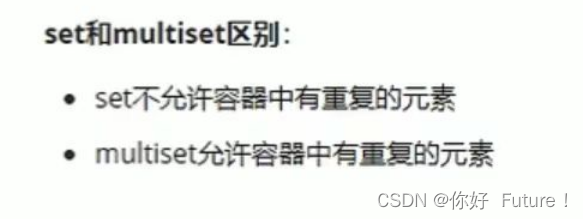
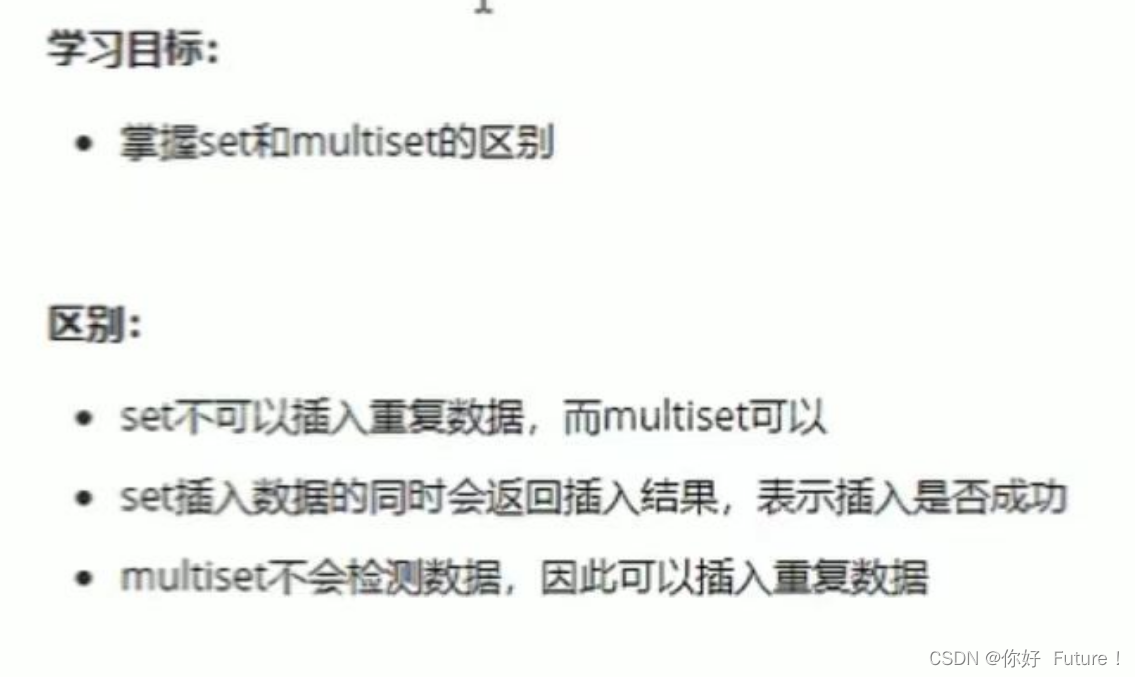
#include<iostream>
#include<set>
using namespace std;
void printSet(const set<int>& L) {
for (set<int>::const_iterator it = L.begin(); it != L.end(); it++) {
cout << *it << " ";
}
cout << endl;
}
void printMultiet(const multiset<int>& L) {
for (multiset<int>::const_iterator it = L.begin(); it != L.end(); it++) {
cout << *it << " ";
}
cout << endl;
}
void insertJudge(pair<set<int>::iterator, bool> ret) {
if (!ret.second) {
cout << "插入失败" << endl;
}
else {
cout << "插入成功,该元素是" << *ret.first << endl;
}
}
int main() {
set<int> s1;
s1.insert(50);
s1.insert(40);
printSet(s1);
pair<set<int>::iterator,bool> ret = s1.insert(40);
insertJudge(ret);
ret = s1.insert(60);
insertJudge(ret);
multiset<int>s2;
s2.insert(40);
s2.insert(40);
printMultiet(s2);
return 0;
}40 50
插入失败
插入成功,该元素是60
40 404.3.1 pair对组(拓展)
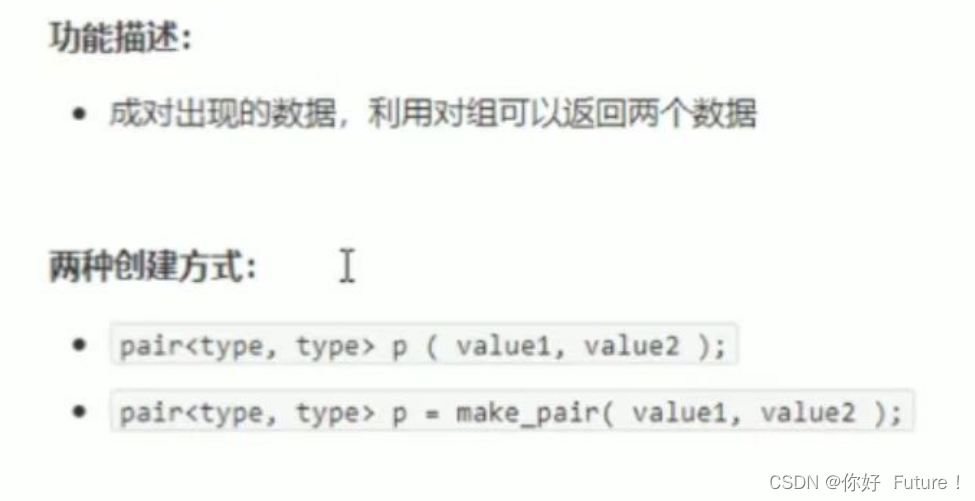
#include<iostream>
using namespace std;
int main() {
pair<int, string> p1(2, "小明");
pair<int, string> p2 = make_pair(3, "小亮");
cout << p1.first << " " << p1.second << endl;
cout << p2.first << " " << p2.second << endl;
return 0;
}2 小明
3 小亮map容器
基本概念
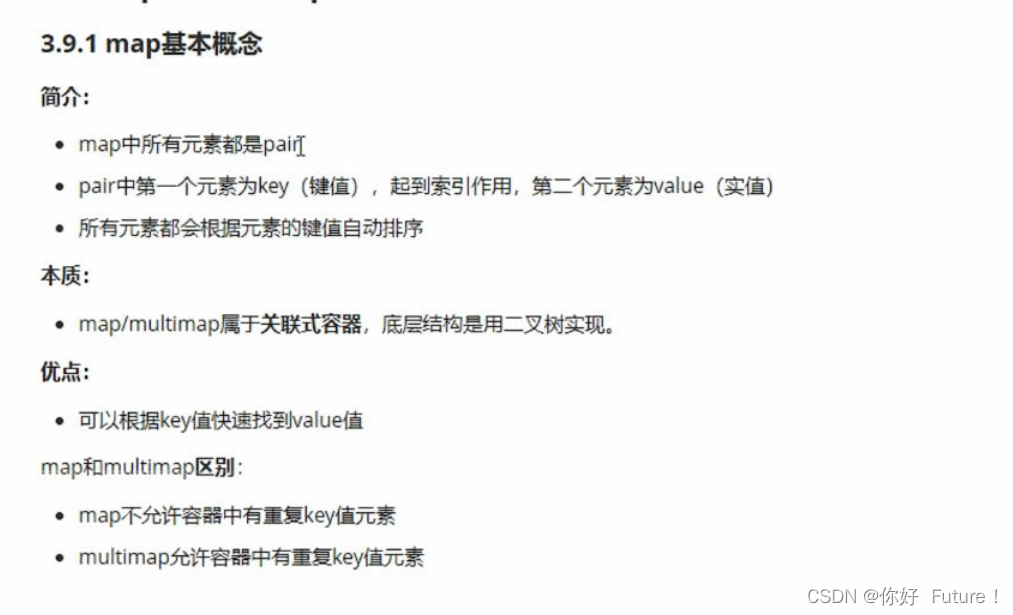
构造和赋值
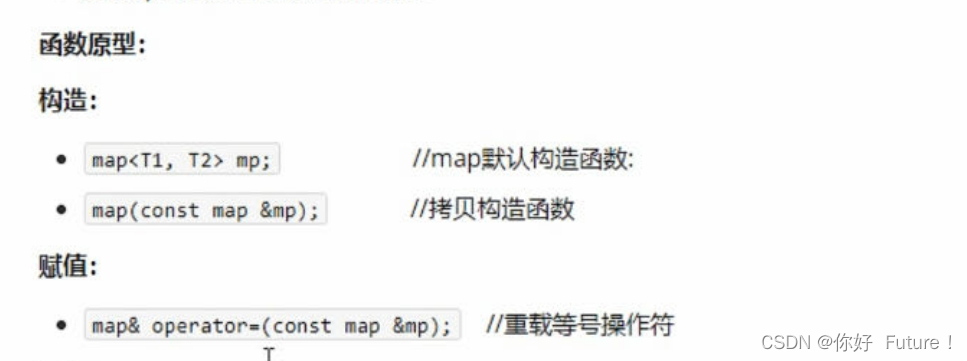
#include<iostream>
#include<map>
using namespace std;
void printMap(const map<int,int>& m) {
for (map<int, int>::const_iterator it = m.begin(); it != m.end(); it++) {
cout << "keyֵ=" << (*it).first << " " << "valueֵ=" << it->second << endl;
}
cout << endl;
}
int main() {
map<int, int>m;
m.insert(pair<int, int>(1, 10));
m.insert(pair<int, int>(3, 30));
m.insert(pair<int, int>(2, 20));
m.insert(pair<int, int>(4, 40));
printMap(m);
map<int, int>m2(m);
printMap(m2);
map<int, int>m3 = m;
printMap(m3);
}key值=1 value值=10
key值=2 value值=20
key值=3 value值=30
key值=4 value值=40
key值=1 value值=10
key值=2 value值=20
key值=3 value值=30
key值=4 value值=40
key值=1 value值=10
key值=2 value值=20
key值=3 value值=30
key值=4 value值=40大小和交换

#include<iostream>
#include<map>
using namespace std;
void printMap(const map<int, int>& m) {
for (map<int, int>::const_iterator it = m.begin(); it != m.end(); it++) {
cout << "keyֵ=" << (*it).first << " " << "valueֵ=" << it->second << endl;
}
cout << endl;
}
int main() {
map<int, int>m1;
m1.insert(pair<int, int>(1, 10));
m1.insert(pair<int, int>(3, 30));
m1.insert(pair<int, int>(2, 20));
m1.insert(pair<int, int>(4, 40));
if (m1.empty()) {
cout << "容器为空" << endl;
}
else {
cout << "容器中的元素个数为:" << m1.size() << endl;
}
map<int, int>m2;
m2.insert(pair<int, int>(6, 60));
m2.insert(pair<int, int>(7, 70));
m2.insert(pair<int, int>(5, 50));
m2.insert(pair<int, int>(8, 80));
//交换前
cout << "交换前" << endl;
printMap(m1);
printMap(m2);
m2.swap(m1);
cout << "交换后" << endl;
printMap(m1);
printMap(m2);
}容器中的元素个数为:4
交换前
key值=1 value值=10
key值=2 value值=20
key值=3 value值=30
key值=4 value值=40
key值=5 value值=50
key值=6 value值=60
key值=7 value值=70
key值=8 value值=80
交换后
key值=5 value值=50
key值=6 value值=60
key值=7 value值=70
key值=8 value值=80
key值=1 value值=10
key值=2 value值=20
key值=3 value值=30
key值=4 value值=40插入和删除

#include<iostream>
#include<map>
using namespace std;
void printMap(const map<int, int>& m) {
for (map<int, int>::const_iterator it = m.begin(); it != m.end(); it++) {
cout << "key值=" << (*it).first << " " << "value值=" << it->second << endl;
}
cout << endl;
}
int main() {
map<int, int>m;
m.insert(pair<int, int>(1, 10));
m.insert(make_pair(3, 20));
m.insert(map<int, int>::value_type(2, 30));
m[5] = 70;
cout << "m[4]的value值为" << m[4] << endl;//[]不建议插入,但[]可以利用key访问到value
printMap(m);
//删除
m.erase(m.begin());
cout << "1: ";
printMap(m);
m.erase(3);//按照key删除
cout << "2: ";
printMap(m);
m.erase(m.begin(), m.end()); //等价于m.clear()
printMap(m);
}m[4]的value值为0
key值=1 value值=10
key值=2 value值=30
key值=3 value值=20
key值=4 value值=0
key值=5 value值=70
1: key值=2 value值=30
key值=3 value值=20
key值=4 value值=0
key值=5 value值=70
2: key值=2 value值=30
key值=4 value值=0
key值=5 value值=70查找和统计

改变排序规则









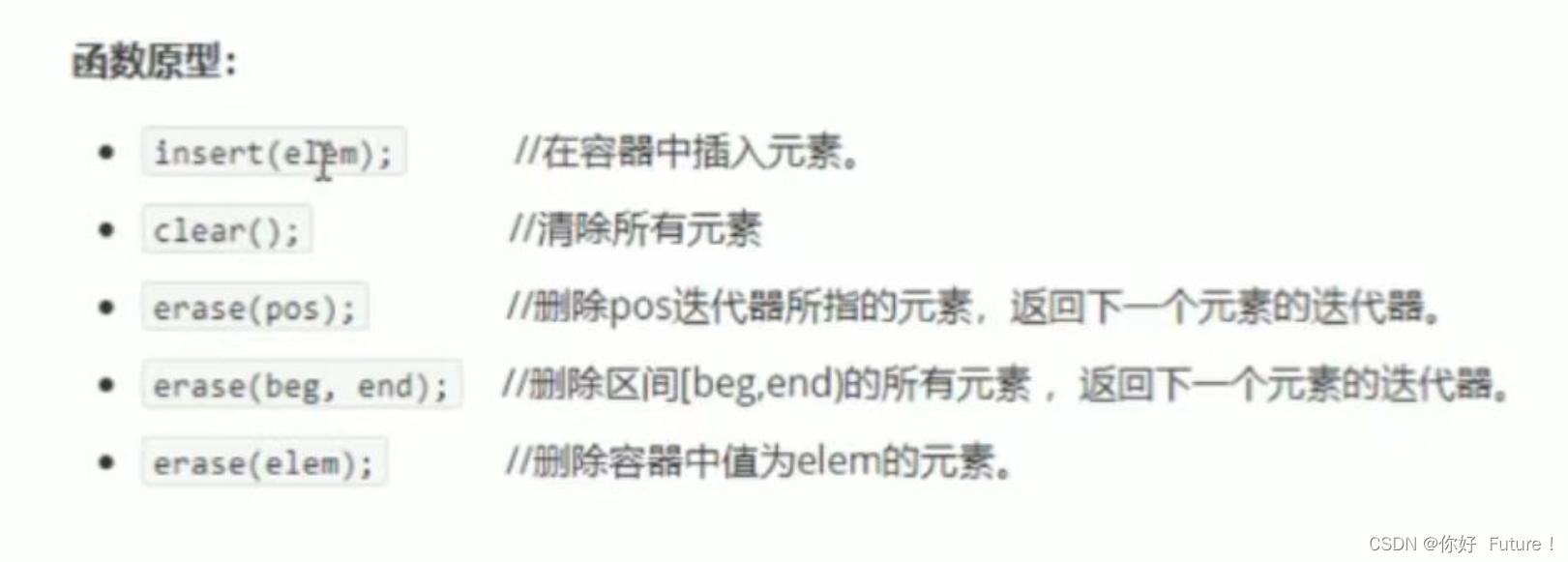














 394
394

 被折叠的 条评论
为什么被折叠?
被折叠的 条评论
为什么被折叠?








